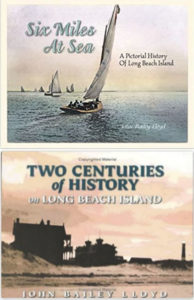by Harlan Radford, Jr
The maritime history of New Jersey’s eastern seaboard has been punctuated with over 4,800 shipwrecks. Covering the span of some 400 years, the New Jersey Shipwreck Database compiled by Beach Haven’s New Jersey Maritime Museum chronicles pertinent details about those many shipwrecks.

One such shipwreck, the Fortuna, became an emblem for the Jersey Shore town that became its graveyard.

The ill-fated Italian bark Fortuna ran aground at what is now Ship Bottom, NJ in 1910.
The grounding of the Fortuna was not the shipwreck that gave the borough of Ship Bottom its name – that is another story.

The arresting Fortuna hulk became one of the most widely photographed wrecks on the Jersey coast and numerous photos depicted people actually climbing the masts, hanging from the bowsprit, and standing on the underside of the ship’s hull.
Fortuna remained visible only during most of 1910 until wreckers cut it up for salvage.

As memories of the wreck faded, vintage postcards and old photographs served as the only testimony as to the evidence of this tragic maritime event.

While violent storms provoked many shipwrecks, incessant coastal fog and darkness also caused many shipwrecks before New Jersey lighthouses were constructed in the latter half of the 1800s.
The heavily traveled shipping traffic to North American cities like New York, Philadelphia, and Boston saw many travelers and cargoes sailing along the Jersey Shore.
Because of the treacherous shifting shoals, numerous inlets, and dangerous sandbars, this area off the Jersey coast earned the ominous name “Graveyard of the Atlantic.”
On January 18, 1910, the three-masted, steel-hulled vessel with a gross tonnage of 924 and measuring 193 feet long, was transporting a cargo of coal from Montevideo, Uruguay bound for the port of New York City.

Built in 1869 in Hamburg, Germany, and sailing under the flag of Italy, the ill-fated final voyage of the Fortuna ran aground at the 16th Street beach at Ship Bottom during rough seas and thick fog.

Members of the Ship Bottom U.S. Life Saving Service saved all 18 persons without casualty including Captain Giovan Adragna, his wife, two children, and a newborn Adragna baby, along with a crew of 13.
That Fortuna has now become associated with the iconography, lore, and history of the seashore town which became its final resting place, has been largely due to the efforts of Brant Beach summer resident Carole Bradshaw.
While walking the beach, Bradshaw came upon some pieces of the ship in 1983. She also discovered Fortuna’s anchor protruding from the sand which was recovered, authenticated, and currently resides on the lawn at the Ship Bottom Borough Hall.

Later, on a frigid but sunny Saturday in January 2010, about 100 persons gathered on the 16th Street beach to witness a historic re-enactment of the wreck of the Fortuna led by Carole Bradshaw.
A scale model replica of the Fortuna sporting white improvised sails, rigging, and an Italian flag atop the three-masted hull bore the name “FORTUNA” in white letters.
 Now known as “The Anchor Lady,” Carole Bradshaw authored Fortuna in 2010, an engaging account of how her discovery in the surf drove her to research how the wreck affected Captain Giovan Adragna’s family by tracking down the now-grown newborn.
Now known as “The Anchor Lady,” Carole Bradshaw authored Fortuna in 2010, an engaging account of how her discovery in the surf drove her to research how the wreck affected Captain Giovan Adragna’s family by tracking down the now-grown newborn.
Bradshaw has presented the Fortuna story to many organizations throughout New Jersey, including the NJ Maritime Museum in Beach Haven.
We invite readers of this intriguing story to share additional insights and information about their memories of the Fortuna shipwreck.
 Photos used with permission from Six Miles At Sea: A Pictorial History of Long Beach Island, New Jersey by John Bailey Lloyd – Down The Shore Publishing, Box 353, Harvey Cedars, NJ 08008 – Copyright 1990 and Two Centuries of History on Long Beach Island by John Bailey Lloyd – Down The Shore Publishing, Box 353, Harvey Cedars, NJ 08008 – Copyright 2005.
Photos used with permission from Six Miles At Sea: A Pictorial History of Long Beach Island, New Jersey by John Bailey Lloyd – Down The Shore Publishing, Box 353, Harvey Cedars, NJ 08008 – Copyright 1990 and Two Centuries of History on Long Beach Island by John Bailey Lloyd – Down The Shore Publishing, Box 353, Harvey Cedars, NJ 08008 – Copyright 2005.


In search of large poster size print of The Fortuna.